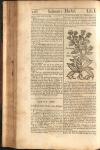
 I. The Names. It is called in ********: in Latin, Buglossum Sylvestre: and in Engish. Wild or field Bugloss, or Ox-Tongue.
I. The Names. It is called in ********: in Latin, Buglossum Sylvestre: and in Engish. Wild or field Bugloss, or Ox-Tongue.
II. The Kinds. There are several Species of the Wild Bugloss, as
- 1. Buglossum Sylvestre majus, flore nigro, The Great Wild Bugloss. (Anchusa undulata. -Henriette.)
- 2. Buglossum Sylvestre minus, The Small Wild Bugloss. (Anchusa arvensis. -Henriette.)
- 3. Buglossum Sylvestre minus Asperum, Rough Wild Bugloss. (Ajuga pyramidalis? -Henriette.)
- 4. Buglossum dulce, ex Infulis Lancastriae, Sweet, or Lancashire Bugloss. (Mertensia maritima. -Henriette.)
III. The Description. The first of these differs little from the Garden Bugloss, but in its greatness, this being larger in every part: and in the color of the flowers, which are of so deep a purple color, that they are accounted as black.
IV. The second Kind, has a small long Root: its Leaves are somewhat broad, short, and rough, smaller than either the former Wild Kind, or the Garden Kind, and something more unevenly dented on the edges: the Flowers grow at the Tops, of a blewish purple color, but smaller than the former, and the Seeds grow three or four together, and blackish also, like the other kinds.
V. The Rough Wild Bugloss, has a Root like the former, but its Leaves are much rougher than any of the other Kinds, and sharper or smaller towards their end: the flowers on the Tops of the Branches, are more like the Flowers of Galiopsis, or Stinking Dead Nettle, than of any of the other sorts of Bugloss: in some Plants they are of a blewish purple color, and in some they are white, but both colors are never found in one Plant.
VI. The Lancashire Bugloss, has a great Root, blackish on the out side, and divided downwards, in several large Arms or Branches, from whence shoots forth many slender Stalks, a foot and half high, more or less. The lower Leaves whereof next the ground, are much lesser than those of Borage, and of a whiter green, and somewhat rough; but those which grow on the Stalks are lesser, having the flowers set at the Joints with them, whose Buds before they are blown, are of a reddish color, but when they are open, of a blewish purple, somewhat like those of Vipers Bugloss, or between them and Borage Flowers, of a very sweet, or Honey like Taste.
VII. The Places. The first, second and third grow Wild in several Countries, and are sometimes found growing Wild in England. The fourth was found by Mr. Hesket growing in one of the Islands about Lancashire.
 VIII. The Times. They all flower in June and July, and their Seed comes to ripeness in a short time after, the Seed growing ripe, even in the time of Flowering.
VIII. The Times. They all flower in June and July, and their Seed comes to ripeness in a short time after, the Seed growing ripe, even in the time of Flowering.
IX. The Qualities, Specification, Preparations, Virtues and Uses, are mostly the same with those of Borage, but especially with those of Vipers Bugloss, of which we treat in Chap. 95. next following.
Botanologia, or The English Herbal, was written by William Salmon, M.D., in 1710.
This chapter has been proofread by Nick Jones.

